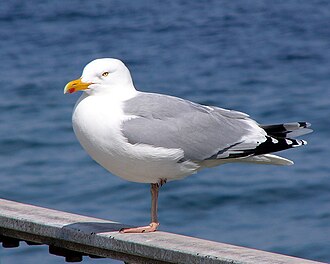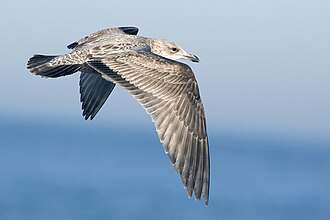Difference between revisions of "Field Guide/Birds/Larus argentatus"
m (125 revisions: re-import from WB, including edit history) |
|||
| (107 intermediate revisions by 20 users not shown) | |||
| Line 1: | Line 1: | ||
| − | + | {{Bird_id | |
| − | + | | name = Herring Gull | |
| − | + | | latin_name = Larus argentatus | |
| − | + | | level = 4 | |
| − | + | | image_1 = Larus argentatus ad.jpg | |
| − | + | | caption_1 = Adult Herring Gull | |
| − | + | | image_2 = Herring gull - natures pics.jpg | |
| − | + | | caption_2 = Juvenile Gull | |
| − | + | | description = The '''Herring Gull''', ''Larus argentatus'', is a large gull which breeds across North America, Europe and Asia. Some herring gulls, especially those resident in colder areas, migrate further south in winter, but many are permanent residents, e.g. those on the lower Great Lakes, on the east coast of North America or at the North Sea shores. Herring Gulls are also abundant around inland garbage dumps, and some have even adapted to life in inland cities. | |
| − | |||
| − | |||
| − | |||
| − | |||
| − | |||
| − | |||
| − | |||
| − | |||
| − | |||
| − | |||
| − | |||
| − | |||
| − | |||
| − | |||
| − | The '''Herring | ||
| − | + | Adult Herring Gulls are similar to Ring-billed Gulls but are much larger, have pinkish legs, and a much thicker yellow bill with more pronounced lower bill. First-winter Herring Gulls are much browner, but second and third-winter birds can be confusing since soft part colors are variable and third-year Herring Gull often show a ring around the bill. Such birds are most easily distinguished by the larger size and larger bill of Herring Gull. | |
| − | + | Adults are easily identified by their size, pale grey back and the red spot on the beak. Legs are pink at all ages. The bird depicted is the western European race ''Larus argentatus argenteus''. The Scandinavian race ''L. a. argentatus'' is slightly larger and darker, with more white in the wing tips. | |
| − | The | + | The North American '''American Herring Gull''' is similar to ''argentatus'', except that immature birds tend to be darker and more uniformly brown. |
| − | + | These are omnivores like most ''Larus'' gulls, and will scavenge on rubbish tips and elsewhere, as well as seeking suitable small prey in fields or on the coast, or robbing plovers or lapwings of their catches. | |
| − | |||
| − | |||
| − | |||
| − | |||
| − | |||
| − | + | Eggs, usually three, are laid on the ground or cliff ledges in colonies, and are defended vigorously by this large gull. The loud laughing call is well-known in the northern hemisphere. | |
| − | + | }}<noinclude>[[Category:Adventist Youth Honors Answer Book/Transcluded Modules|{{FULLCHAPTERNAME}}]]</noinclude> | |
| − | |||
| − | |||
| − | |||
| − | |||
| − | Eggs, usually three, are laid on the ground or cliff ledges in colonies, and are defended vigorously by this large gull. The loud laughing call is well-known in the northern hemisphere. | ||
| − | |||
| − | < | ||
| − | |||
Latest revision as of 19:12, 5 July 2012
| Larus argentatus (Herring Gull) | |
|---|---|
| Description | |
| The Herring Gull, Larus argentatus, is a large gull which breeds across North America, Europe and Asia. Some herring gulls, especially those resident in colder areas, migrate further south in winter, but many are permanent residents, e.g. those on the lower Great Lakes, on the east coast of North America or at the North Sea shores. Herring Gulls are also abundant around inland garbage dumps, and some have even adapted to life in inland cities.
Adult Herring Gulls are similar to Ring-billed Gulls but are much larger, have pinkish legs, and a much thicker yellow bill with more pronounced lower bill. First-winter Herring Gulls are much browner, but second and third-winter birds can be confusing since soft part colors are variable and third-year Herring Gull often show a ring around the bill. Such birds are most easily distinguished by the larger size and larger bill of Herring Gull. Adults are easily identified by their size, pale grey back and the red spot on the beak. Legs are pink at all ages. The bird depicted is the western European race Larus argentatus argenteus. The Scandinavian race L. a. argentatus is slightly larger and darker, with more white in the wing tips. The North American American Herring Gull is similar to argentatus, except that immature birds tend to be darker and more uniformly brown. These are omnivores like most Larus gulls, and will scavenge on rubbish tips and elsewhere, as well as seeking suitable small prey in fields or on the coast, or robbing plovers or lapwings of their catches. Eggs, usually three, are laid on the ground or cliff ledges in colonies, and are defended vigorously by this large gull. The loud laughing call is well-known in the northern hemisphere. | |


